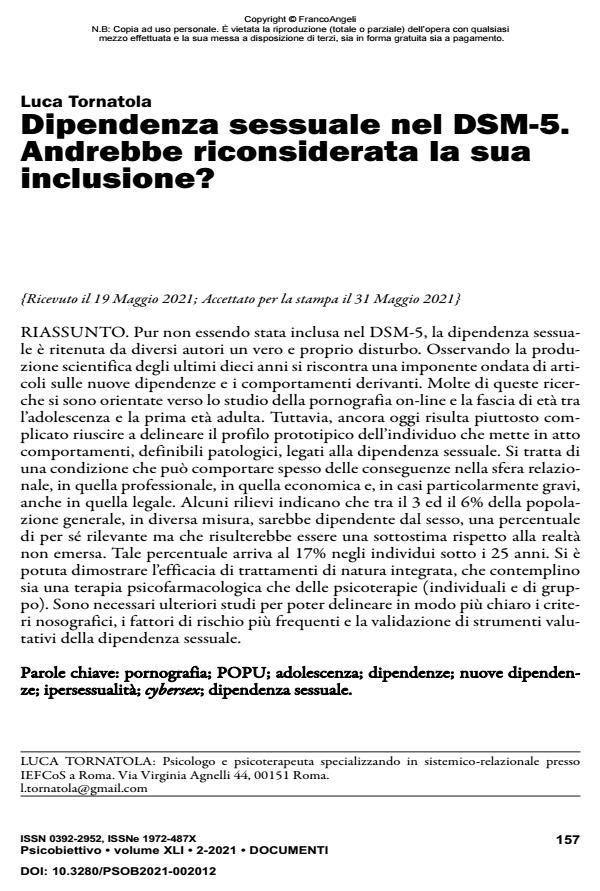Sexual addiction in the dsm-5. should its inclusion be reconsidered?
Journal title PSICOBIETTIVO
Author/s Luca Tornatola
Publishing Year 2021 Issue 2021/2 Language Italian
Pages 10 P. 157-166 File size 109 KB
DOI 10.3280/PSOB2021-002012
DOI is like a bar code for intellectual property: to have more infomation
click here
Below, you can see the article first page
If you want to buy this article in PDF format, you can do it, following the instructions to buy download credits

FrancoAngeli is member of Publishers International Linking Association, Inc (PILA), a not-for-profit association which run the CrossRef service enabling links to and from online scholarly content.
Although not included in the DSM-5, sexual addiction is considered by several authors to be a real disorder. Looking at the scientific production of the last ten years, there has been a massive wave of articles on new addictions and the resulting behaviors. Much of this research has focused on the study of online pornography and on the age range between adolescence and early adulthood. However, it is still difficult to establish the prototypical profile of the individual who engages in this conduct in a pathological manner. It is a condition that can often have serious consequences in the relational, professional and economic spheres and, in severe cases, even in the legal sphere. Some findings indicate that the percentage of people among the general population who, to varying degrees, are sex addicted is between 3 and 6 per cent, which in itself is a significant figure but would be an underestimate compared with the reality that has not emerged. This percentage rises to 17% in the case of individuals under 25 years of age. It has been possible to demonstrate the effectiveness of integrated treatments, including both psychopharmacological therapy and psychotherapy (individual and group). Further studies are needed to define more clearly the nosographic criteria, the most frequent risk factors and the validation of assessment instruments for sexual addiction.
Keywords: pornography; POPU; adolescence; addictions; new addictions; hypersexuality; cybersex; sex addiction.
- Allen A., Kannis-Dymand L., Katsikitis M. (2017) “Problematic Internet pornography use: The role of craving, desire thinking, and metacognition”, Addictive Behaviors, 70: 65-71.
- American Psychiatric Association (1987) Diagnostic and Statistical Manual of Mental Disorders (3rd ed., rev.), Washington, DC American Psychiatric Association (2000) Diagnostic and Statistical Manual of Mental Disorders ( fourth edition, text revision), Washington, DC
- Amodeo M. (2015) “The addictive personality”, Substance Use and Misuse, 50(8-9): 1031-1036. DOI: 10.3109/10826084.2015.100764
- Avenia F., Pistuddi A. (2007) Manuale sulla sexual addiction – Definizioni, diagnosi, interventi. Clinica delle dipendenze e dei comportamenti di abuso, FrancoAngeli, Milano
- Carnes P.J. (2000) “Sexual Addiction and Compulsion: Recognition, Treatment &Recovery”, CNS Spectrums, 5(10): 63-72
- Coleman S.B., Kaplan J.D., Downing R.W. (1986) “Life Cycle and Loss – The Spiritual Vacuum of Heroin Addiction”, Family Process, 25: 5-23.
- Crosby J.M.; Twohig M.P. (2016) “Acceptance and Commitment Therapy for Problematic Internet Pornography Use: A Randomized Trial”, Behav. Ther., 47: 355-366
- Fong T.W. (2006) “Understanding and managing compulsive sexual behaviors”, Psychiatry (Edgmont), 3(11): 51-8. PMID: 20877518; PMCID: PMC2945841
- Goodman A. (1992) “Sexual addiction: Designation and treatment”, Journal of Sex and Marital Therapy, 18: 303-314 Hardy S.A., Ruchty J., Hull T., Hyde R.A. (2010) “Preliminary Study of an Online Psychoeducational Program for Hypersexuality”, Sex. Addict. Compuls., 17: 247- 269
- Kor A., Fogel Y., Reid R.C., Potenza M.N. (2013) “Should Hypersexual Disorder be Classified as an Addiction?”, Sexual Addiction & Compulsivity, 20(1-2). DOI: 10.1080/10720162.2013.76813
- Levine M.P., Troiden R.R. (1988) “The myth of sexual compulsivity”, Journal of Sex Research, 25: 347-363
- Reid R., Garos S., Carpenter B. (2011) “Reliability, Validity, and Psychometric Development of the Hypersexual Behavior Inventory in an Outpatient Sample of Men”, Sexual Addiction & Compulsivity, 18: 30-51. DOI: 10.1080/10720162.2011.55570
- Short M.B., Wetterneck C.T., Bistricky S.L., Shutter T., Chase T.E. (2016) “Clinicians’ Beliefs, Observations, and Treatment Effectiveness Regarding Clients’ Sexual Addiction and Internet Pornography Use”, Commun. Ment. Health J., 52: 1070-1081
- Sirianni J.M., Vishwanath A. (2016) “Problematic Online Pornography Use: A Media Attendance Perspective”, Journal of Sex Research, 53(1): 21-34. DOI: 10.1080/00224499.2014.98049
- Sniewski L., Farvid P., Carter P. (2018) “The assessment and treatment of adult heterosexual men with self-perceived problematic pornography use: A review”, Addict. Behav., 77: 217-224
- Swift R.M. (2013) “Naltrexone and Nalmefene: Any Meaningful Difference?”, Biological Psychiatry, 73(8): 700-701.
- Twohig M.P., Crosby J.M. (2010) “Acceptance and commitment therapy as a treatment for problematic Internet pornography viewing”, Behav. Ther., 41: 285-295
- Young K.S. (1996) “Psychology of computer use: XL. Addictive use of the Internet: A case that breaks the stereotype”, Psychological Reports, 79: 899-902
- Young K.S. (2007) “Cognitive behavior therapy with Internet addicts: Treatment outcomes and implications”, Cyberpsychol. Behav., 10: 671-679
- Weiss R. (2012) “Sexual Addiction, Hypersexual Disorder and the DSM-5: Myth or Legitimate Diagnosis?”, Counsellor, The Magazine for Addiction Professionals, Feature Articles 2012/Sep-Oct
Luca Tornatola, Dipendenza sessuale nel DSM-5. Andrebbe riconsiderata la sua inclusione? in "PSICOBIETTIVO" 2/2021, pp 157-166, DOI: 10.3280/PSOB2021-002012